The 10 Best Buildings in London You Should Visit If You Love Architecture
Hint: The Walkie Talkie didn’t make it to this list
What to visit in London when you’re short of time? That’s a question we get asked often. And the answer is tricky because it depends on what you’re looking for. This time, we’ll assume you are after the buildings mainly and only.
What are London’s best buildings? The real challenge here is to narrow down the list. Sure, we could make a list of 50 amazing structures, or wait a second, we could even write a book about it — wink wink — but to make a short list of London’s best of the best is difficult, because there is so much to choose from.
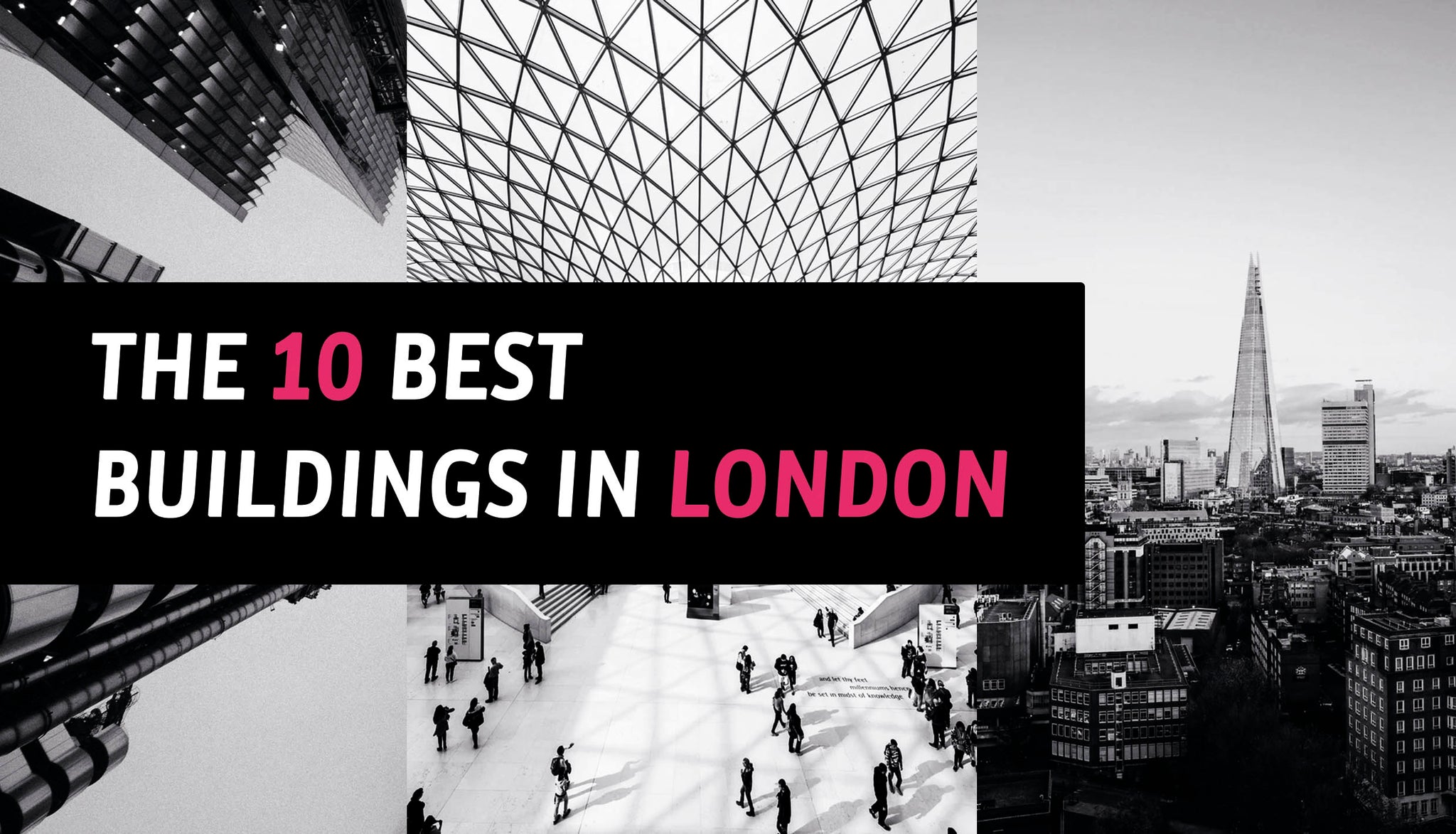
Today (with much sweat and calculation) we are selecting our top 10 buildings based on the social impact they had, the skill of the architects and builders and the relevance it still has in London. Though some of these are good-looking and iconic structures, being pretty or popular wasn’t the criteria. If you’re looking for Instagrammable locations, look somewhere else.
Without further ado, here’s the top 10, the 10 buildings that make London what it is and the 10 you, dear crazy architecture lover, should prioritise immediately in your ‘amazing places to visit in London’.
For more inspiration, get your Architectour Guide of London
1. Lloyd’s Building
Rogers Stirk Harbour + Partners (1986)
📕 Page 167

The history of insurance is fascinating, especially in port cities like London. Ship and cargo insurance was embedded in the culture and people informally gathered in coffee shops to discuss their businesses while gaining or losing outrageous amounts of money. Edward Lloyd’s coffee shop on Tower Street was firmly established by 1688 and it became the foundations of the Lloyd’s of London we know today.
In 1928 the first Lloyd’s Building opened on this location after more than 200 years of history. It was the first building it had ever owned and was designed in a Neo-Classical style. After several building expansions, a competition for a new building was held in 1978. What happened later is a breakthrough of architectural styles in London.
In 1986 a well-established insurance company built the first modern steel and glass tall tower of London. The bold design included emergency stairs, ducts and lifts on the outside of the building allowing for easy replacement and maintenance. The final touch of the building? It kept the original 1928 entrance. If you haven’t noticed, this building wasn’t designed to please anyone, and that’s one of the reasons why we love it so much.
Why should you visit? It was the first modern steel and glass building in London and what took Richard Rogers’ architectural career to the next level.
Location: 1 Lime Street, EC3M 7HA (Google)
Nearest Tube Station: Bank / Monument
2. Tate Modern
Giles Gilbert Scott (1963), Herzog & de Meuron (2000, 2016)
📕 Page 199
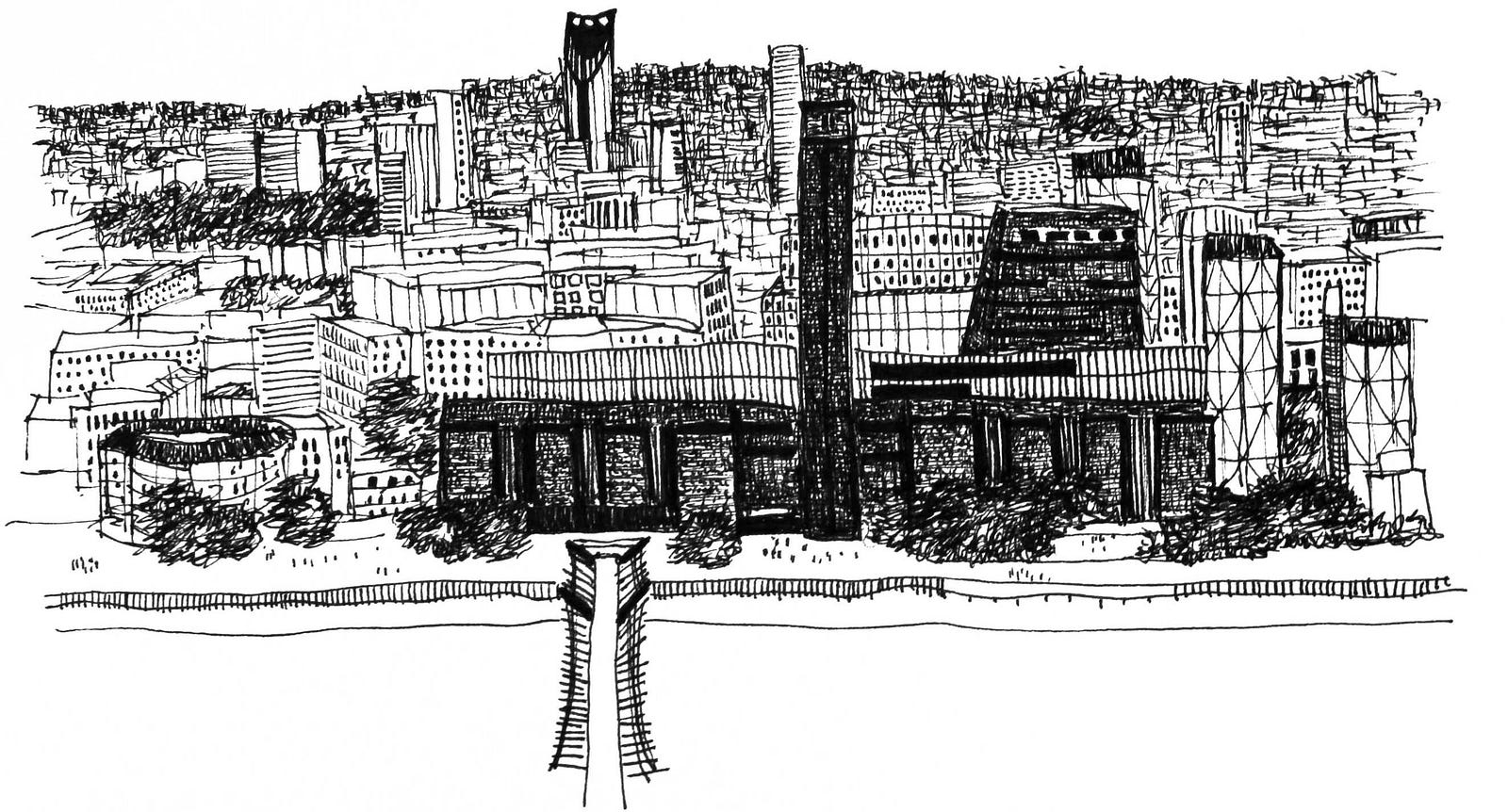
Before the National Theatre was erected, the south bank was a polluted and horrible place. Factories pestered an already problematic area, historically known for its prisons and brothels. However, the fate of the area changed dramatically when these sites were replaced for cultural venues.
Bankside Power Station, designed by Gilbert Scott in 1963, was completed in a time when things were already changing and closed soon after in 1981. Demolition of this megastructure would have been unjustified and a new life was injected into the building: a gallery. London is famous for reusing its buildings but this was on a different scale.
Tate Modern opened in 2000 with a hopeful and positive program that further influenced the development of the area for the better. Millennium Bridge opened at the same time. Borough Market got refurbished. And London Bridge Station started having discussions on how to improve its facilities. The size of the project, quality of the program and popularity of its extension is overwhelmingly blissful.
Why should you visit? It’s a powerful example of renovation and area regeneration.
Location: Bankside, London SE1 9TG (Google)
Nearest Tube Station: Southwark
3. Sir John Soane’s Museum
John Soane (1824)
📕 Page 117

John Soane was the ingenius architect behind the Bank of England (now mostly destroyed), Dulwich Picture Gallery and the previous Freemasons’ Hall. His architecture is well-known in Britain and it’s one of the most reputed architects of London of all times.
His personal life, however — full of ups and downs, financial issues and family turmoil — is less known. One of the reasons why you can visit his house as a museum is because he made sure he left some productive source of income to his badly-behaved son George. In fact little George Soane tried to extort money from his father threatening to otherwise become an actor 😅.
This house is not only what provided money to his family after his death but also his most personal den. Where he coexisted with his work, obsessions and collectables around the world while producing wonderful buildings. You can understand his buildings and historical era a lot better by seeing this delightful house of wonders.
Why should you visit? Check for yourself the personal homely madness of a successful architect of the 18th century
Location: 13 Lincoln’s Inn Fields, Holborn, London WC2A 3BP (Google)
Nearest Tube Station: Holborn
4. Barbican Estate
Chamberlin, Powell and Bon (1976)
📕 Page 149
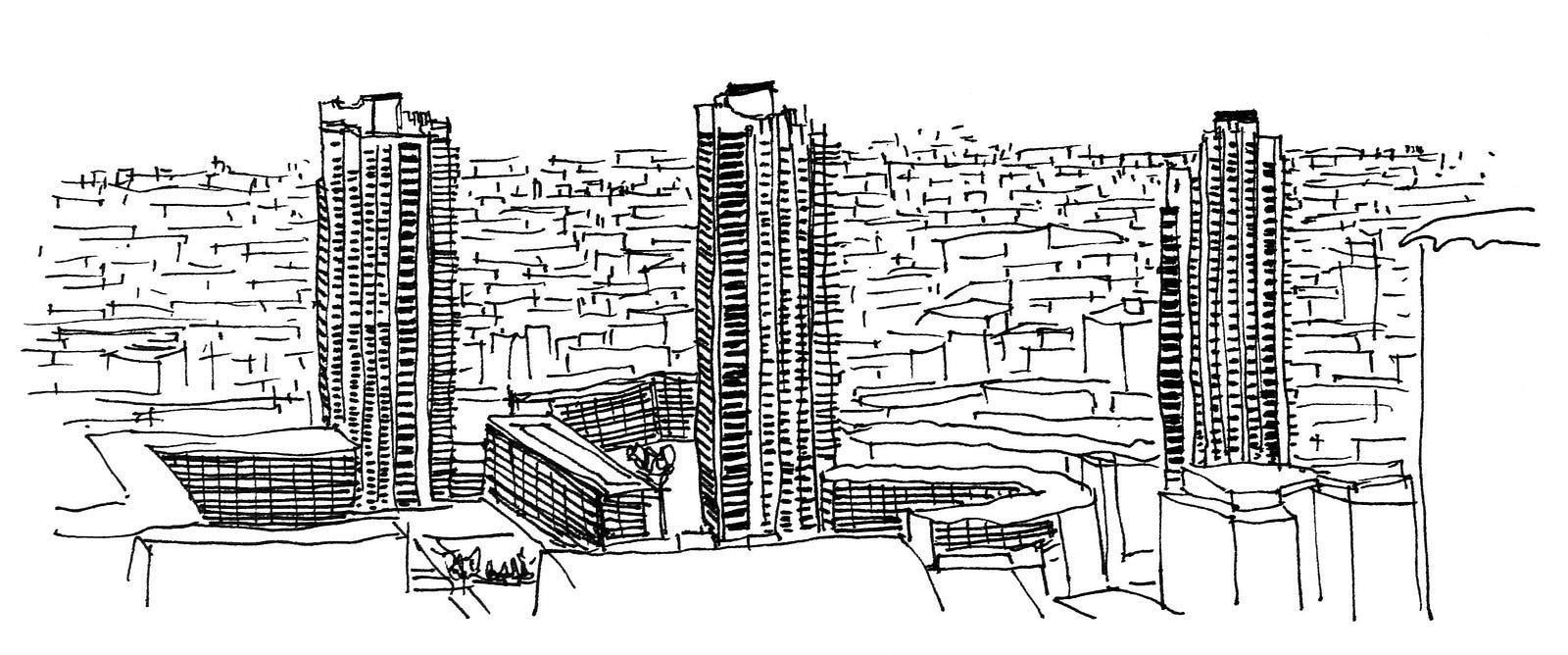
After the war, London had an unprecedented amount of free space to develop. This hunger for progress and newly built constructions led the capital to some of the worst architecture ever erected in London. Most of the post-war buildings have been problematic and are progressively being demolished. Very little is left of those horrendous office concrete blocks, especially within the City of London.
Barbican, completed in 1976, was designed in the same style of other highly problematic and dense housing developments, but it got very lucky. Two factors influenced the success of this huge development: the privatisation of council estates and its location within the City of London. This says a great deal about British housing policy over the past 40 years.
What’s really interesting about the Barbican Estate complex is that, though similar to other failed council estates, it not only managed to survive but also to improve every year since its completion; bringing more cultural program, people and creating a space that is increasingly unique. That is really the case study of Barbican.
Why should you visit? A huge built utopia that still, almost half a century after its construction, is thriving.
Location: Silk St, EC2Y 8DS (Google)
Nearest Tube Station: Barbican
5. Westminster Abbey
Henry of Reyns (1245), Nicholas Hawksmoor (1745), George Gilbert Scott (1865)
📕 Page 4
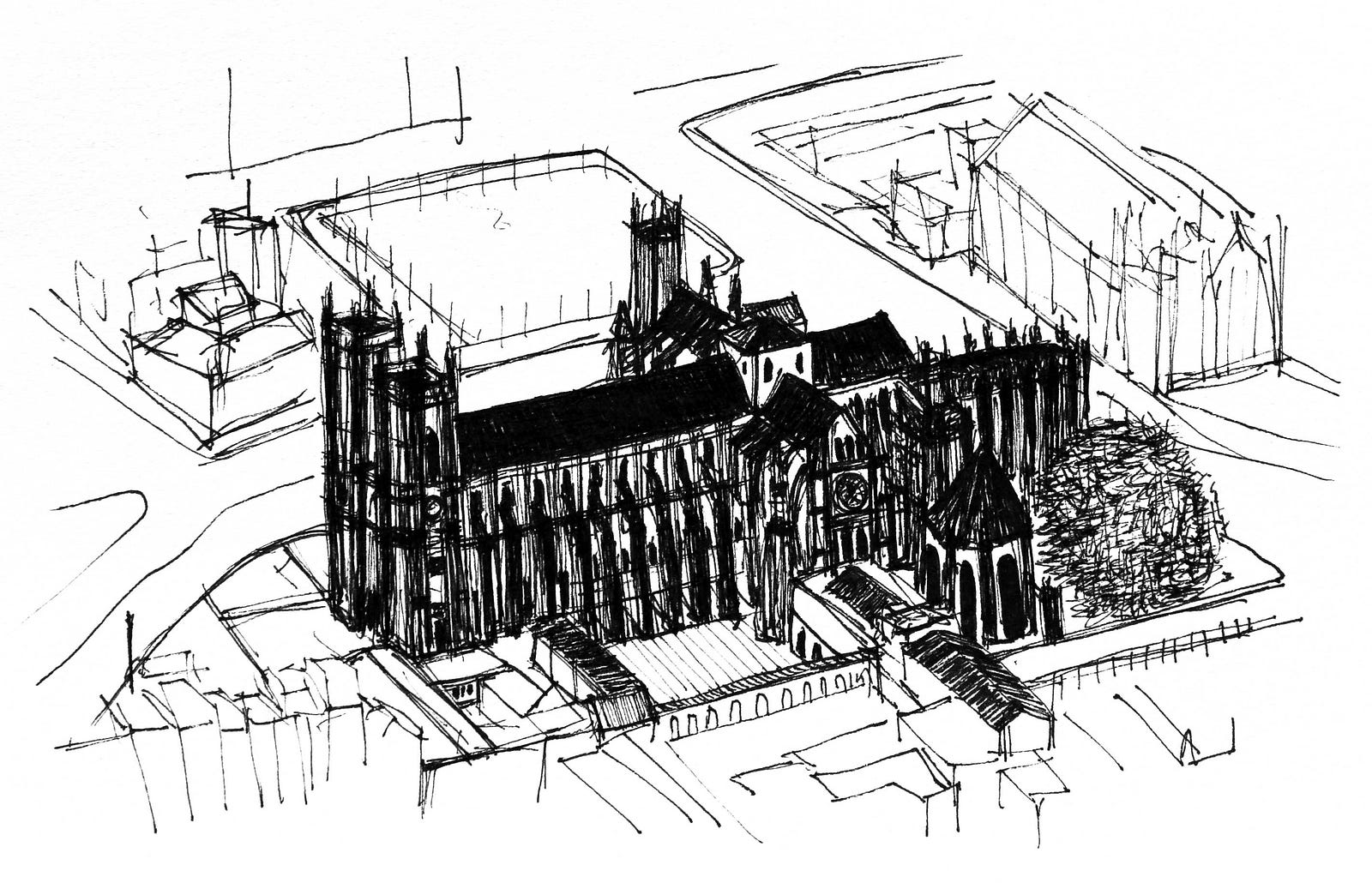
England’s royal history began here. Edward the Confessor rebuilt St Peter’s Abbey, a small Benedictine abbey, to provide himself with a royal burial church. In 1066 the first official coronation took place here with William the Conqueror starting a tradition that is still in force nowadays.
Some parts of Westminster Abbey date from 1245 and layers and layers of history speak about London’s wars, religious changes, aspirations, culture and power. Every single English (and later British) monarch since 1066 has taken place here except two Edwards (the Fifth, who was murdered in the Tower as a child, and the Eighth, who abdicated).
When the Unknown Warrior was buried here in 1920 after the First World War, the Abbey was again witness to a crucial historical moment. Also as meaningful as other personalities (some of them foreign) that are buried in Westminster Abbey too. But beware, the events that don’t take place here also represent a great deal of meaning.
Why should you visit? It represents everything that Britain is.
Location: 20 Deans Yd, Westminster, London SW1P 3PA (Google)
Nearest Tube Station: Westminster
6. The Shard
Renzo Piano (2013)
📕 Page 192
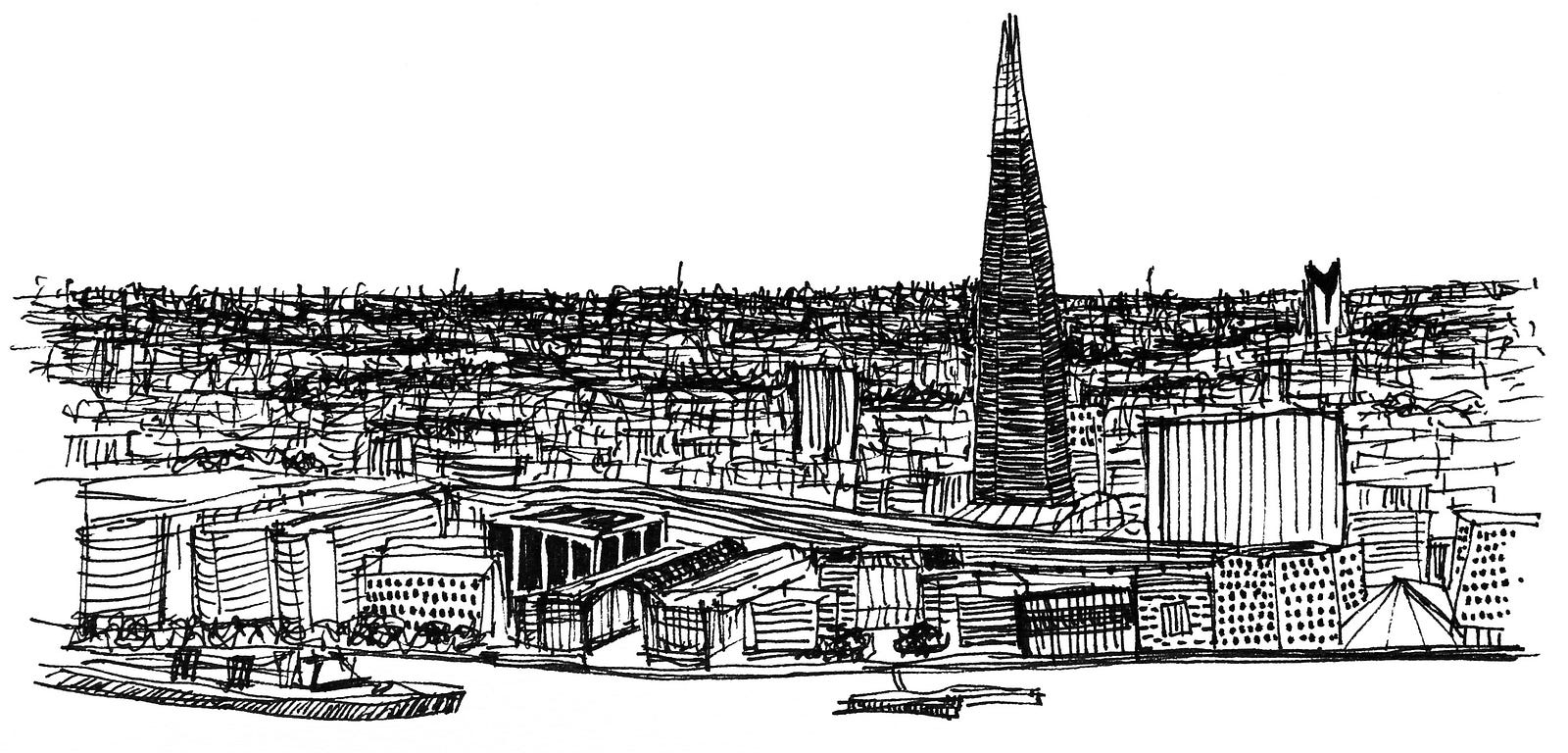
In a city like London with strict codes, decent architecture and access to the world’s leading architects, is not so easy to actually get things to be built. Big teams of lawyers, political figures and the general public are involved in what gets or doesn’t get built in the capital. So the fact that the Shard, the EU’s tallest building, got approved and erected means a great deal.
Was it a coincidence that the tallest structure in London was neither in the City of London nor Canary Wharf? Was it another coincidence that the architect of the tallest structure — a task normally commissioned to American firms such as SOM or Kohn Pedersen Fox — was left to a firm whose leading architect was Italian?
The most enigmatic of all, and probably a key piece of the puzzle, is the ownership. This tall and ambitious skyscraper — a British icon let’s say — belongs to the State of Qatar.
Why should you visit? It’s the tallest building in London, Britain and the EU.
Location: 32 London Bridge St, London SE1 9SG (Google)
Nearest Tube Station: London Bridge
7. The British Museum
Robert Smirke (1852), Foster + Partners (2000), Rogers Stirk Harbour + Partners (2014)
📕 Page 99
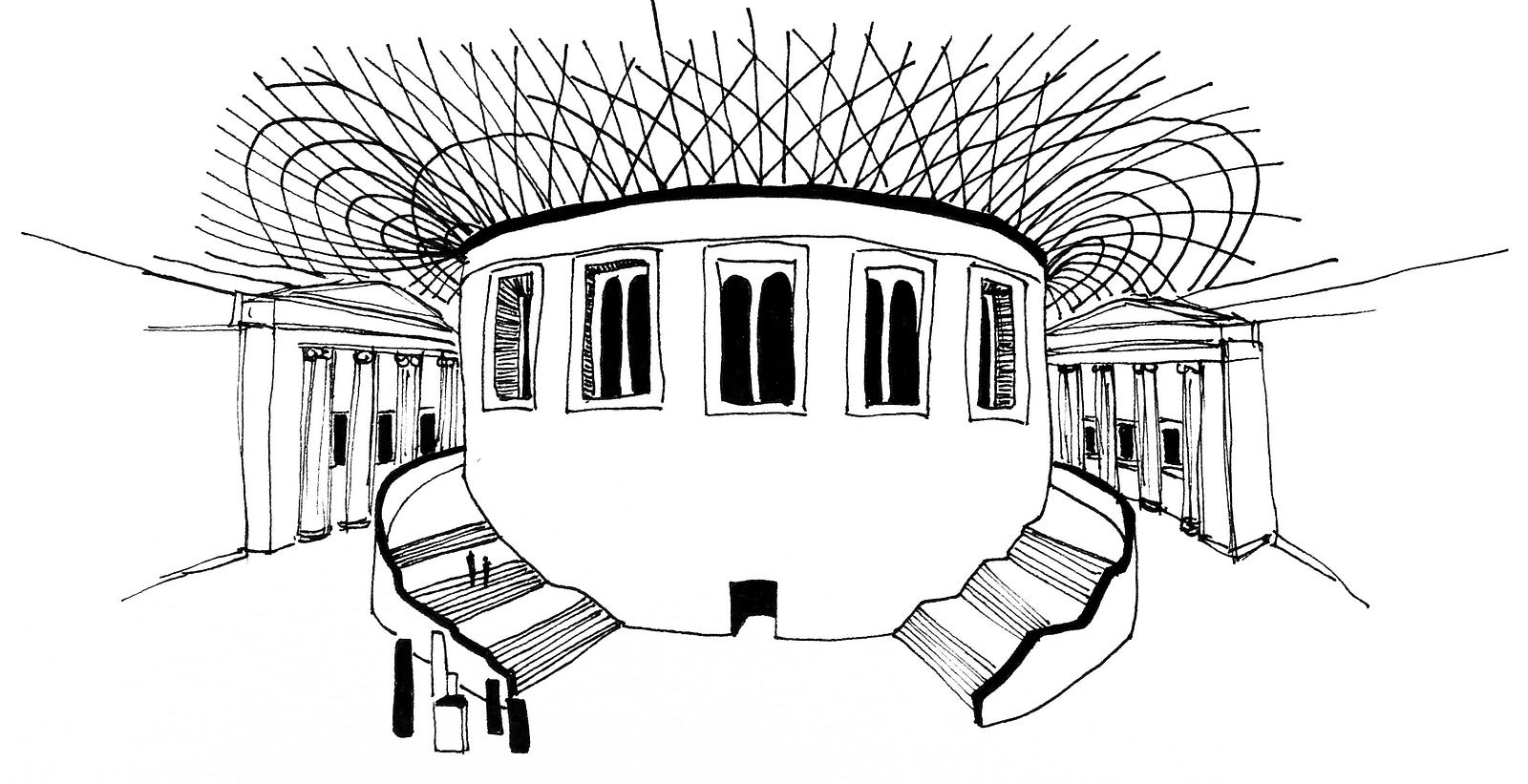
The British Museum was founded in the most atypical of conditions, at least in comparison to other European collections. The museum has its origin in the personal collection of a physician, not a monarch. In 1759 Hans Sloane opened to the public his personal collection of objects from around the world.
Montagu House, the original museum, grew to be what it is nowadays. In fact, this location has always been where the museum is. Its expansion has had a lot to do with many curious collectors and, of course, colonisation. However, you must also know that in most cases these collectors bought the objects and that’s an important remark.
The constant preservation work carried out by the British Museum is remarkable and in very few places around the world would you have the opportunity to access so much in so little space. For Free.
Why should you visit? One of the world’s top 5 museums
Location: Great Russell St, Bloomsbury, London WC1B 3DG (Google)
Nearest Tube Station: Holborn / Tottenham Court Road
8. St Pancras Station
William Henry Barlow and George Gilbert Scott (1868), Aedas (2013)
📕 Page 94
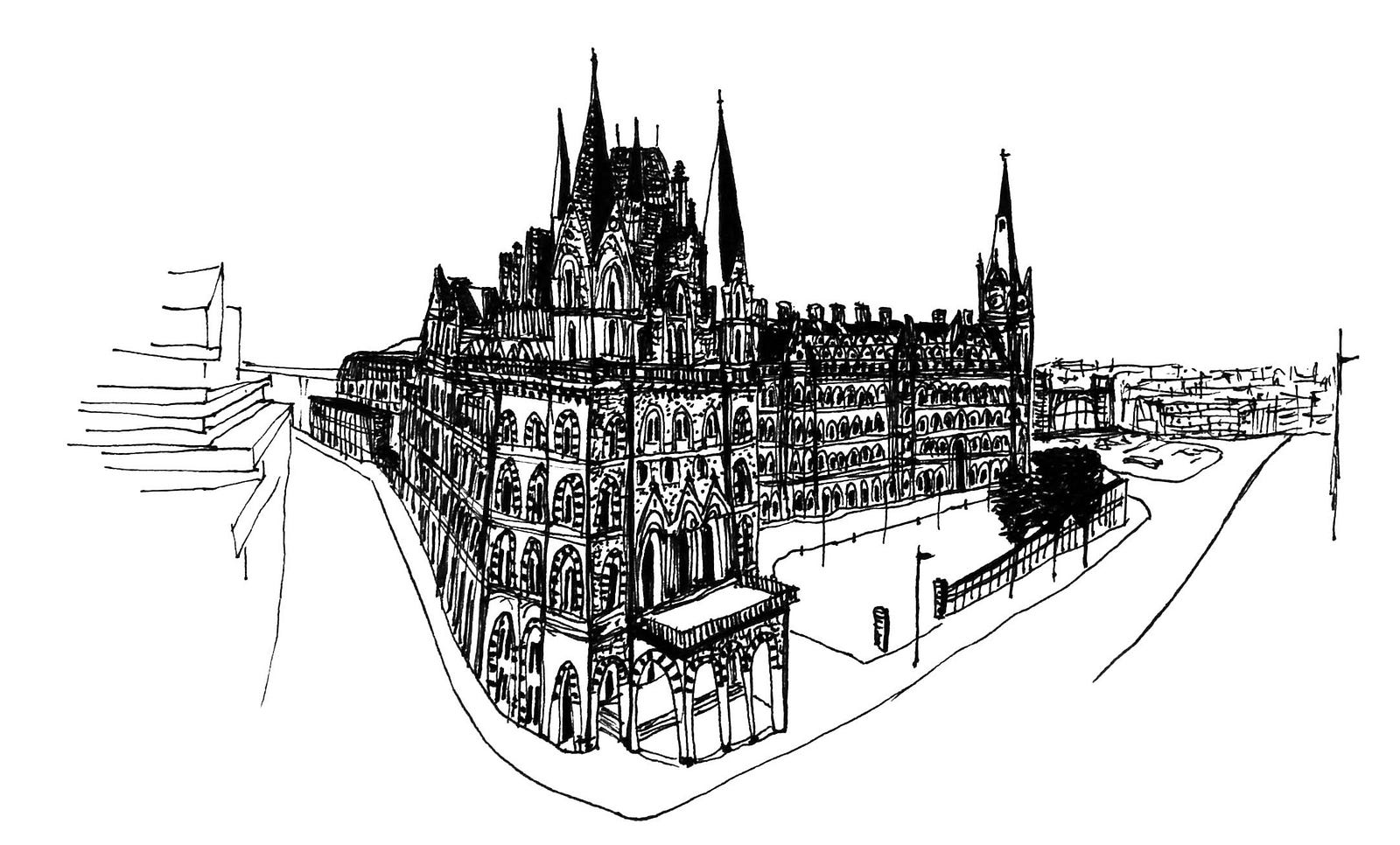
When did hotels as an architecture typology begin? Just after the affluence of the railway. Passengers were carried from everywhere in the country to London in very little time. Some of these passengers came to London for fun and leisure and they liked to be looked after in the city. Therefore, train stations also became a synonym of hotels.
St Pancras Station, completed in 1868, had an enormous iron and glass roof — the largest in the world at the time — and the Midland Grand Hotel (now the St Pancras Renaissance Hotel) was as luxurious as it gets. It had many innovative features such as hydraulic lifts, concrete floors, revolving doors and fireproof floor constructions.
Although the interiors have been refurbished and the hotel occupies more space than it used to (the old ticket office is now a superb bar), one can appreciate the details of such a magnificent construction.
Why should you visit? London’s most grandiose railway station and one the first hotels as we now know them.
Location: Euston Rd, N1C 4QP (Google)
Nearest Tube Station: King’s Cross St. Pancras
9. The Queen’s House
Inigo Jones (1635)
📕 Page 229

Inigo Jones had recently completed Banqueting House with much success. The pristine white building was a big contrast within the darkened brick structures around Whitehall. Anne of Denmark commissioned Inigo Jones to design her new home in Greenwich (an area long associated with British monarchy).
The problem? Anne of Denmark died before its completion so Queen Henrietta Maria (wife of her son King Charles I) took over the project. The result is wonderful. Rooms were made even more stylish, white and gold was everywhere and more emphasis was put into the main staircase — the Tulip Staircase — that later became the inspiration of many others.
What’s so special about this house nowadays is that the subsequent (and perhaps also stubborn) monarchs took much care into preserving the views from the house. The whole complex including newer buildings such as Greenwich Hospital are in harmony thanks to that determination.
Why should you visit? It’s Britain’s first classical building.
Location: Romney Rd, Greenwich, London SE10 9NF (Google)
Nearest Tube Station: Cutty Sark for Maritime Greenwich DLR Station
10. The Churchill Arms
Unknown, (1750)
📕 Page 64
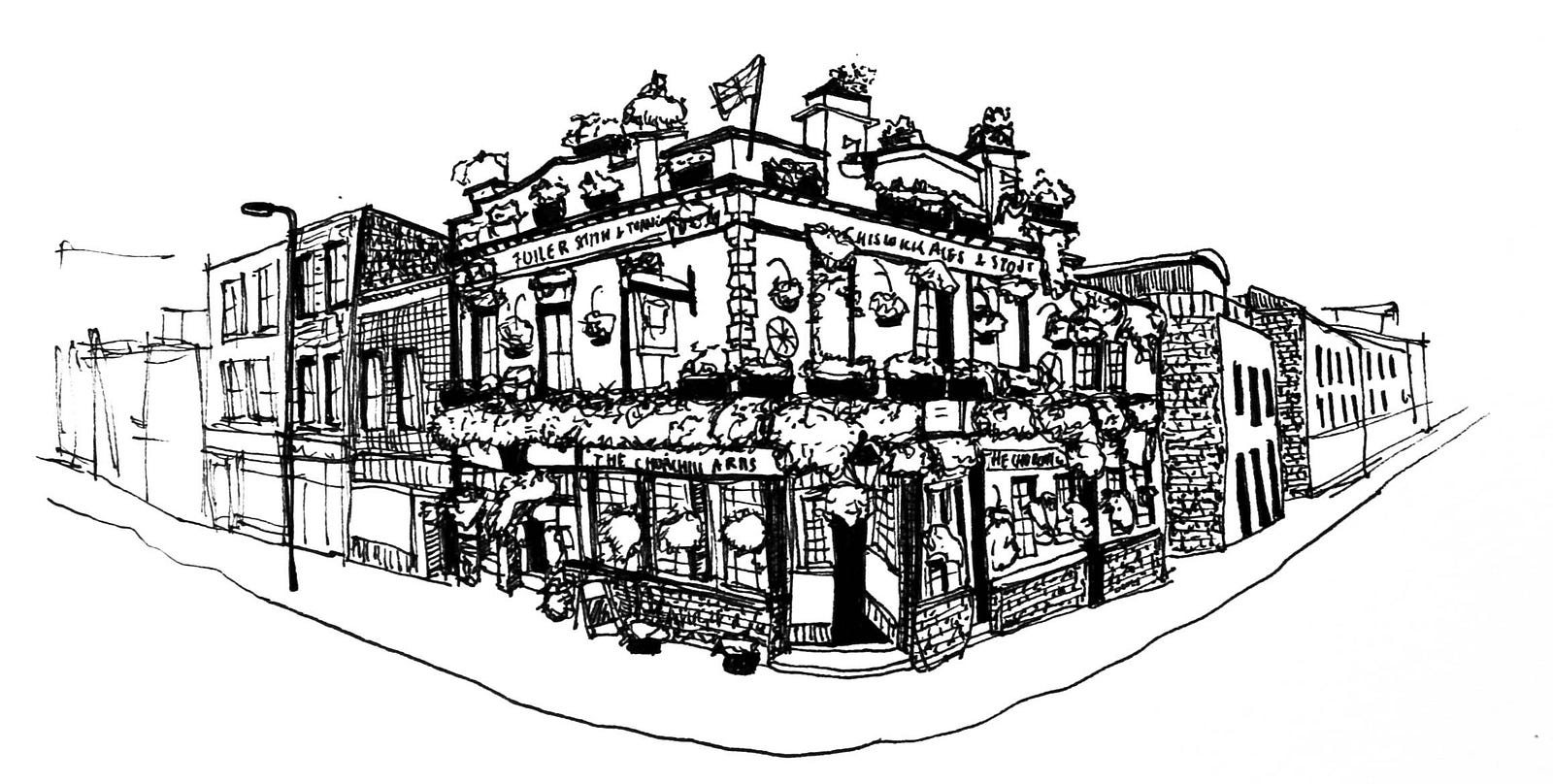
Last but not least — a very delightful type of architecture — the pub. The Churchill Arms is more than a pretty face, it’s been here and used for the same purposes since 1750, making it one of the most historical pubs in the capital.
Public Houses or Pubs were a place where people would eat and drink and also spend the night. If you were wondering where the commoners slept while on ‘business trips’ here you have the answer.
On top of providing the best ales and ciders to quench your thirst, The Churchill Arms is also serving Thai food. Admittedly, the other reason to come here is its beauty. Hundreds (maybe thousands?) of flowers adorn the façade making it a happy place to snap a photo.
Why should you visit? It’s the most beautiful of this very British architecture category: the Pub 😉
Location: 119 Kensington Church St, Kensington, London W8 7LN (Google)
Nearest Tube Station: Notting Hill Gate
We hope you liked this list and get yourself started as there are another 280+ locations waiting for you in London. If you need some help to arrange your plan or want to listen to London’s quirkiest and most fun stories, then make sure to book a tour with us.

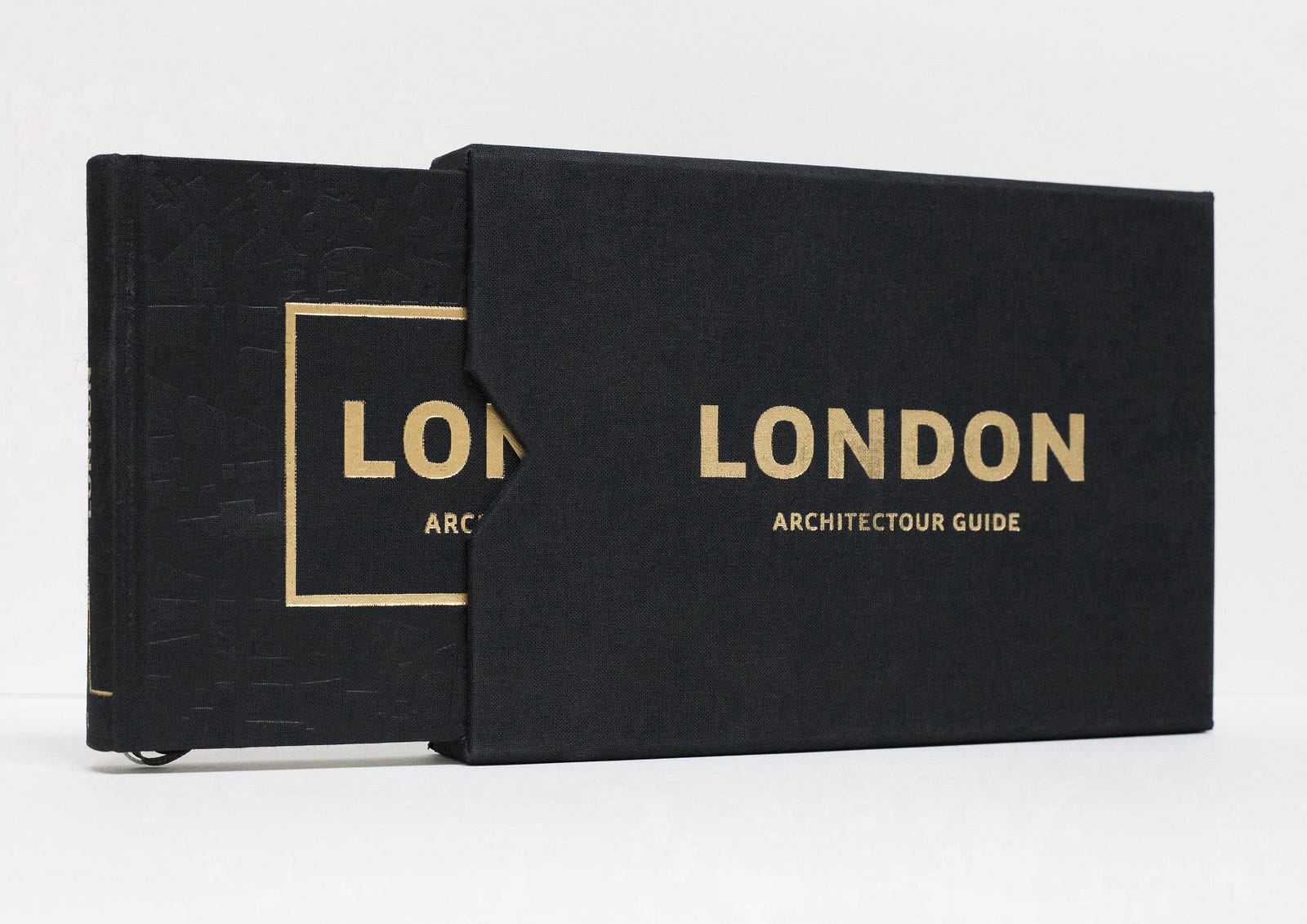
Excellent selection; keep up the good work.